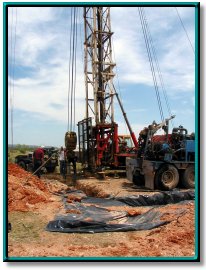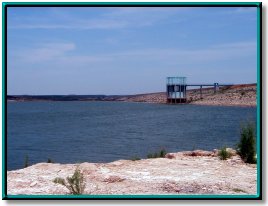E. V. Spence Reservoir
Counties: Coke, Mitchell, Nolan
Parameters: Total Dissolved Solids (TDS), Sulfate
River Basin: Colorado River
Segment: 1411
On this page:
- Background and Goals
- Description of Watershed
- Status
- Public Participation
- Approved I-Plan
- Adopted TMDLs
- For More Information
Background and Goals
Water quality testing in E. V. Spence Reservoir found that excessive salinity caused by levels of sulfate and total dissolved solids (TSD) are affecting the lake and its use for drinking water. The goal of this project is to reduce point and nonpoint sources of these pollutants to restore and maintain water quality standards for the reservoir.
Description of Watershed
The E.V. Spence Reservoir is located in the upper Colorado River Basin in Coke County. With a surface area of 15,893 acres, it is an important source of water for more than 300,000 people in surrounding cities, including Big Spring, Odessa, Midland, and San Angelo. Additionally, the reservoir serves mining and industrial uses, and it is a popular destination for recreational fishermen.
Status
The Texas State Soil and Water Conservation Board completed a large project to eliminate salt cedar from the watershed. They used both chemical and biological treatment methods to reduce salt cedar from 11,391 acres in the area below Lake J.B. Thomas and south to the E.V. Spence Reservoir.
To reduce salinity, the Colorado River Municipal Water District (CRMWD) has been managing diversions of fresh water from the Colorado River into the reservoir since 2001. Prior to the drought of 2010–2011, the levels of saline contaminants were dropping in E.V. Spence Reservoir and the watershed of the Colorado below it. Then, due to persistent drought, water levels in the reservoir dropped drastically. This, in turn, led to a high concentration of chloride, sulfate, and TDS. As of 2022, chloride, sulfate, and TDS still exceed the criteria.
The Railroad Commission of Texas (RRC) and TCEQ committed $2.6 million to identify and plug 171 abandoned and orphaned oil wells to eliminate that source of pollution through 2002. As CRMWD finds new wells, they notify RRC and work to plug them. The RRC also completed a study to evaluate other management practices that would reduce or prevent salinity in the streams that flow into the reservoir.

Plugging a well in the
E.V. Spence Watershed
Public Participation
A steering committee was formed in April 1999 to solicit advice, comments, and ideas from interested parties. Membership included a diverse cross-section of stakeholders in the upper Colorado River Basin, including representatives from industry, agriculture, petroleum operations, environmental groups, private citizens, and government agencies.
Approved I-Plan
The commission approved the I-Plan on Aug. 10, 2001.
- I-Plan for Sulfate and Total Dissolved Solids TMDLs in the E.V. Spence Reservoir
- Response to Public Comment on the E.V. Spence I-Plan
Adopted TMDLs
The commission adopted these TMDLs on June 14, 2002. EPA approved these TMDLs on May 9, 2003, at which time they became part of the state's Water Quality Management Plan (WQMP).
-
Two TMDLs for Total Dissolved Solids and Sulfate in the E.V. Spence Reservoir
Segment 1411 - Response to Public Comment on the E.V. Spence TMDLs
Revisions to TMDLs
From time to time, it is necessary to revise TMDLs to account for changing conditions in the watershed. Revisions to the load allocations in TMDLs are made via the state’s WQMP, which is updated quarterly.
The WQMP provides projected effluent limits for use in planning and permitting activities under the Texas Pollutant Discharge Elimination System (TPDES). The TCEQ reviews all applications for new and amended permits for conformance with applicable portions of the WQMP, including adopted TMDLs.
Update(s)
Updates are made to account for changing conditions in the watershed, such as new or revised wasteload allocations, permits that have been canceled or have expired, or changed facility names. Updates use the same units of measure as the original TMDL.
- July 2009, Appendix III, page 10
WQMP updates may be viewed in person at the TCEQ Library, Building A, 12100 Park 35 Circle, Austin, Texas. Electronic versions of updates published from 2014 through the present are available on the Texas State Library and Archives Commission website .
For WQMP updates prior to 2014, use the TRAIL Search the TCEQ engine as outlined below. The main search box on the page will only conduct a simple search with no exclusionary parameters and should not be used.
- First, limit your search to TCEQ only. Do this via the advanced search feature on the left of the page. To limit a search to TCEQ content, enter “www.tceq.texas.gov” or “www.tceq.state.tx.us” into the “From the Host” search box.
- Refine your search to narrow down results. The other search boxes on the left of the page allow for search terms to be included, excluded, or used in an exact phrase search. Date ranges can be used as well.
For More Information
Please email tmdl@tceq.texas.gov and mention the E.V. Spence Reservoir in the subject line. Or call us at 512-239-6682.





 Back to top
Back to top